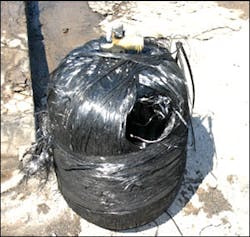Composite LPG Cylinder Test Burns: No BLEVE
Recently, the Nassau County Fire Academy in New York conducted live fire tests on the new lightweight fiberglass composite LPG (propane) cylinders that are now available for sale to the public in the New York area. Present at the testing were members from the Nassau County Fire Academy, Nassau County Fire Marshals and Suffolk County Fire Academy.
The purpose of this testing was to learn what effects fire had on these new cylinders and to develop recommended incident guideline procedures for an incident involving this type of cylinder. Two separate tests were conducted and both involved a 20-pound composite cylinder filled to its normal capacity of 80 percent with liquid propane. (see photo 1)
Test # 1 - Pool Fire: The cylinder was placed on an open metal grate approximately five inches above a pool of burning fuel oil. (see photos 1 and 2) and the following results were noted: At three minutes the outer protective casing burned away, the relief valve fired at 3 minutes and 25 seconds, venting at the neck of the cylinder at four minutes (photo 3), breach of the cylinder shell at 4 minutes 25 seconds (see photos 4 and 5) and complete burn off at 16 minutes. There was no BLEVE and the cylinder remained upright throughout the entire test.
Test # 2 - Flame Impingement: The cylinder was placed approximately three feet from the end of a propane torch pressure fire and the following was noted. At less then one minute the outer protective casing burned away (see photo 6), the relief valve fired at two minutes (see photo 7), venting at the neck of the cylinder at three minutes (see photo 8). There was no breach of the cylinder shell (see photo 9) and complete burn off at 14 minutes. There was no BLEVE and the cylinder remained upright throughout the test.
Results of the test fires and research conducted the reveal the following: The composite cylinder's potential to BLEVE is remote. The cylinder wall can be breached by fire and although there is no catastrophic destruction of the cylinder as in a BLEVE, a large plume of fire can vent out from the breach.
The cylinder valve and relief valve is the same as on a steel LPG cylinder. The valve on the composite cylinder is threaded through the composite and held in place by a steel flange on the inside of the cylinder. When sufficient heat/fire is applied to the neck the composite opens and fire will vent from around this attachment point. The valve does remain in place and is not blown out. The cylinders remained in place at all times until hit by a hose stream.
Response Recommendations:
- Members must be aware that these cylinders are now in the county.
- Follow standard LGP response guidelines.
- Need to ID the cylinder construction - visual and ask questions.
- If determined to be a composite tank involved in fire - do not approach, fire can vent out from any point on the cylinder. Approach only after the cylinder has become stable. If there is minor fire involvement at the composite cylinder then extinguish the fire.
- If it is a composite cylinder, water can be directly applied to any exposure first
- Steel cylinders still require immediate water application to points of flame impingement.
- Composite cylinder is lighter - use caution to avoid displacement by hose stream.
- Be cautious, follow safe operational procedures, wear full protective gear and SCBA, stay upwind and use distance and shielding for protection.
Slideshow Images:
Related:
